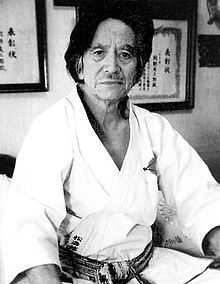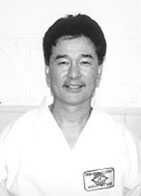Kenkojuku
 | |
| Kenkojuku | |
|---|---|
| Also known as | "kenko" |
| Date founded | 1942 |
| Country of origin | Japan |
| Founder | Tomosaburo Okano (1922-2003) |
| Arts taught | Karate |
| Ancestor arts | Okinawan Martial Arts, karate, kendo, kobudo, Iaido |
| Ancestor schools | Shōtōkai, Shōrin-ryū, Chito Ryu, Goju Ryu |
| Official website | http://karate-do.main.jp/ |
Kenkojuku is a style of Shotokan karate similar to JKA style. It was founded by Tomosaburo Okano. Kenkojuku karate is similar to the teachings of Gichin Funakoshi and modifications made by Funakoshi´s son Yoshitaka Funakoshi. JKA Shotokan differs slightly in that it was Masatoshi Nakayama's version of Shotokan. Okano's/Yoshitaka's Kenkojuku karate and JKA karate are becoming more similar compared to other types of Shotokan karate such as Shigeru Egami's Shotokai.
General description
Since the style is more biomechanically sound and self-defense oriented, there are notable differences in the way many techniques are performed; by comparison with JKA shotokan karate. For example: The rising block or Age-uke is performed by aligning the ulna bone in the forearm, with the arm and not by twisting the ulna bone as the usual jodan uke. There is a wider arc made at the startup position for the soto uke, the gedan barai is more a check than full power block. The double hand blocks have various "hands together" start-up positions. The shotokan kenkojuku style originally had a lower, more demanding kokutsu dachi and neko ashi dachi stances and a more vertical shuto uke / shuto uchi (known as Seiryuto uke /uchi). The Mawashi geri or round kick is performed in a slight downward angle. Within the style´s katas; these show better relationship / linkage patterns between the various movements between basic - intermediate and advanced katas. The kata Niseishi (Chito Ryu version) is included in the Dan grade syllabus instead of Nijūshiho, as well as other katas from another styles such as Goju Ryu); In the kata Bassai, the "yama tsuki" is performed in a shorter arc. Finally, the style´s free fighting position is similar to a crouching lunge position holding both fists in a vertical forward position, protecting the body's center line, as holding a sword; and the style's kumite is more focused on continuous fighting and combinations as in boxing, rather than the usual stop-and-start sport kumite for points, or WKF sport karate kumite.
Kenkojuku karate also includes both traditional Okinawan (Bō, tonfa, sai, nunchaku) and Japanese weapons training, also known as kobudo. The style also includes training in the martial art of drawing the Japanese sword or Iaido within its´ syllabus; since Okano was also a 7th Dan of Iaido, from the Japan Kendo Federation.
Kenkojuku comes under the jurisdiction of the Kenkojuku Karate Association, which was founded by Tomosaburo Okano, a student of Gichin Funakoshi, and a lead of the school of Shotokan karate. The association's motto is "Inner Strength with Outward Humility." Since Okano's death, the Kenkojuku Budokan is run by his son Tomokatsu Okano, from the hombu dojo located in Tokyo. Okano was also a noted expert in the field of flower arrangement or Ikebana specifically roses which became a passion of his, in later years.
Notable Instructors
Tomosaburo Okano

The founder and chief instructor of the Kenkojuku Shotokan Federation was Tomosaburo Okano. Born in 1922, he was a student of Gichin Funakoshi. He was a member of Funakoshi's karate association the Dai Nihon Karate-do Shotokai.
In 1942, Okano was given permission to start a karate research club named Kenkokai Karate-bu in his hometown of Hachiōji, Tokyo. The club was started with the help of Suzuki Shinjo, Kaneko Isamu and Takagi Yoshitomo. He renamed the dojo Kenkojuku Budokan in 1948.
Okano's karate was influenced by both Gichin and Gigo Funakoshi, and eventually this branch of Shotokan became known as Kenkojuku Shotokan. He retained the Shotokai lineage as well as the name Shotokan.
Okano was on the panel of Masters of the Japan Karate-do Federation (JKF), being an 8th Dan in karate. and was also a 7th Dan of Iaido, from the Japan Kendo Federation. He died on July 19, 2003, at the age of 81.
Some of his most famous students were/are Takashi Akuzawa, Toyotaro Miyazaki, Kazuo Kuriyama, Masakazu Takahashi, Koji Sugimoto, Minoru Horie, John Slocum, Larry Durst, Ted Ratich, Bernard Pierce, Fred Hamilton, Stuart Hirschfield, Joseph Butrim and Armando Comacho.
Toyotaro Miyazaki
Toyotaro Miyazaki was born in Tokyo, Japan and began his karate training at the age of 15 under Tomasaburo Okano at the Kenkojuku dojo. He trained in Shotokan Karate until his mid twenties before going to the United States. He achieved fame as a competitor in both kata and kumite. His skills put him on the covers of Black Belt magazine, Karate Illustrated and Official Karate. In Flushing, New York Miyazaki taught over 30 years thousands of students and has produced hundreds of black belts, some of whom have become instructors at their own karate dojos.
Miyazaki was a former instructor of the Long Island University Karate Instructor's Certification program. He is currently Head of the International Shotokai Federation. He retired from teaching and closed the Tokutai dojo in 2004 due to illness. In 2010 and early 2011 he could be found visiting the daytime classes at the Shotojuku dojo in Astoria, Queens. In mid-2011 he decided to return to teaching. His dojo is now called Shotokai USA and is located in Bayside, Queens, NYC.
Masakazu Takahashi

Takahashi has 8th dan and is head of the United States Kenkojuku Karate Association. Takahashi began his karate training in 1961 under Tomosaburo Okano. In 1971, he traveled to America to teach Kenkojuku karate. Originally teaching in Queens, he has two dojos located in Mt. Kisco and Amityville, New York that have been established for more than 41 years.
Koji Sugimoto
Koji Sugimoto was born in Tokyo, Japan in 1947. At the age of fourteen he began karate under Tomosaburo Okano, a student of Gichin Funakoshi.
In 1970, Sugimoto emigrated to Florida. In Miami, he joined with Akuzawa and assisted at his dojo. In the early seventies, he began teaching in Dade County. In the late seventies he began to sponsor tournaments. In 1978 he invited Okano to a tournament at Palmetto High School. Okano’s demonstrations served as great learning experiences for Sugimoto’s students. In the early eighties Okano visited again and held several demonstrations, including kenjutsu (sword).
During the eighties, Sugimoto ran AAU Karate tournaments in the State of Florida. He sponsored annual Kenkojuku tournaments which were held at FIU (Florida International University).
In the early nineties, he received 6th Dan from the All Japan Karate-do Federation (JKF) and received the title shihan. Sugimoto also holds 7th Dan in the World Karate Federation (WKF).
Sugimoto has spread Kenkojuku Shotokan style of karate to the United States, Europe, South America, Central America and the Caribbean. Sugimoto has had close relationships and given certifications to several Shotokan kenkojuku Dojos in Latin America. Presently Sugimoto teaches in South Dade County and at the Miami Dade College Kendall campus.